
Herbal Diabetes Treatments Used in the Casablanca Region
Jim Crocker
18th April, 2024

Image Source: Natural Science News, 2024
Key Findings
- In Morocco, a study found 47 plants used by diabetics for managing their condition
- Sesame, garden cress, fennel, and rosemary were among the most popular plants used
- These findings could lead to new diabetes treatments based on traditional medicine
References
Main Study
1) Ethnobotanical survey on herbal remedies for the management of type 2 diabetes in the Casablanca-Settat region, Morocco.
Published 15th April, 2024
https://doi.org/10.1186/s12906-024-04468-4
Related Studies
2) Hypoglycemic and hypolipidemic effects and antioxidant activity of fruit extracts from Lycium barbarum.
Journal: Life sciences, Issue: Vol 76, Issue 2, Nov 2004
3) Ethnobotanical studies of medicinal plants used by Traditional Health Practitioners in the management of diabetes in Lower Eastern Province, Kenya.
4) Exploring the antibacterial, antidiabetic, and anticancer potential of Mentha arvensis extract through in-silico and in-vitro analysis.



 7th April, 2024 | Greg Howard
7th April, 2024 | Greg Howard